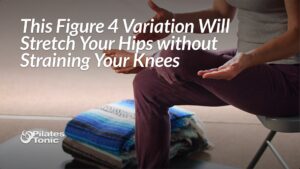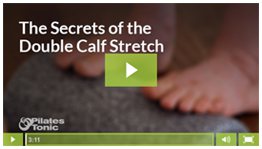I’ve come a long way in my personal alignment journey over the last decade. I can totally relate to the challenge and awkwardness that goes along with changing not-so-great habits we’ve unknowingly built into our body.
For example, I used to walk and sit with my tailbone tucked underneath me and this felt completely normal and totally comfortable.
But, as I began to learn more about the human body, alignment and movement, I also learned where my pelvis actually needed to be for optimal alignment and whole-body health.
Boy did it feel awkward and wrong at first and that was a real shock as I realized how out of alignment and completely unaware I'd been all my life.
Correcting my pelvis tucking habit has been a HUGE process. Unfortunately, it’s not something that you can discover, fix on the spot, and then be good to go for the rest of your life.
It’s a day-by-day retraining process that has the potential to be really annoying at times.
But, once you discover where your pelvis needs to be and how that feels, instead of being frustrated or annoyed, you can celebrate the fact that you noticed.
The very first step to changing poor alignment patterns is discovering what they are. Then you can begin to change the pattern by catching yourself when you fall into it.
So, catching yourself in a sub-optimal alignment pattern is HUGE to recognize because if you don’t catch it when it’s happening, you can’t correct it!
My optimal alignment feels normal to me now. But, when I get tired or stressed I still revert to my old patterns of holding my body. I’ve learned to take it as a cue to check in with myself and see how I’m feeling and what’s going on around me.
My old patterns let me know it’s time for me to take a breather, or get some rest.
A few years ago, after I thought I’d gotten super familiar with it and nailed my optimal pelvic alignment, I was humbled to learn that I was still secretly tucking my pelvis a little bit.
The small shift I still needed to make revealed itself while I was trying to find neutral on my hands and knees. In today’s video, I’m taking you through the exercise that led me to this discovery!
Check out the video, give the exercise a try and let me know what you think. I’d love to hear how it goes in the comments below.
See you in the studio,
Sydney
P.S. Today’s video builds on our last post, so make sure you check out the Drawstring Abdominals video first if you haven’t already!





17 Responses
This is an interesting variation of a similar exercise found in Restorative Exercise™, by Katy Bowman. There is one important difference: conscious vs. reflexive activation of the abdominals. In RE, the goal of this exercise is to bring ribs and pelvis into alignment, while breathing and holding this position so that core activation occurs reflexively. It’s also he preparatory move for squatting in RE™.
From the RE™ perspective, a conscious ‘gathering’ or ‘drawing in’ would be to fight tension with tension. During RES week, it was very difficult for us Pilates teachers to switch off that strategy and really find alignment!
Hi Julie, This particular variation comes from Marie-José Blom. I can completely see the RE™ perspective as well. Thanks for sharing!
Hi Julie, This particular variation comes from Marie-José Blom. I can completely see the RE™ perspective as well. Thanks for sharing!
I found this very informative… as usual! Thank You!
Sydney, what chronic health problems occur with Pelvis Tucking. Believe it or not …some of my clients ( and myself)… feel they are thrusting their abdomen out,in correct alignment!
Hi Shelah, The pelvis is the pedestal for the spine and when that pedestal is chronically tucked, it keeps the lumbar spine in flexion. This isn’t so bad in and of itself, it’s the chronically tucked nature that creates the issue. Especially, when your spine is already in flexion from a tucked pelvis and then you go to pick something up adding rotation to the mix. My brother (sorry, Brian!) “threw his back out” this way picking up a Kleenex! Another side effect of chronically tucking is a short and tight posterior pelvic floor. When the pelvis stays tucked, the tailbone and sacrum get pulled into the pelvis. Glute activation is not accessible when the pelvis is tucked and this combo of tight/short pelvic floor muscles coupled with a lack of glute activation is a recipe for pelvic floor dysfunction. These are just two health issues tucking the pelvis creates. In the long run, chronically tucking the pelvis affects bone density, knee, hip and even neck health! I know it sounds extreme, but as I gain more understanding of how alignment affects whole body health, it makes total sense. I can also totally relate to how awkward optimal alignment feels at first! You might enjoy Katy Bowman’s book Alignment Matters and/or Move Your DNA. Thanks for your question!
Hi Shelah, The pelvis is the pedestal for the spine and when that pedestal is chronically tucked, it keeps the lumbar spine in flexion. This isn’t so bad in and of itself, it’s the chronically tucked nature that creates the issue. Especially, when your spine is already in flexion from a tucked pelvis and then you go to pick something up adding rotation to the mix. My brother (sorry, Brian!) “threw his back out” this way picking up a Kleenex! Another side effect of chronically tucking is a short and tight posterior pelvic floor. When the pelvis stays tucked, the tailbone and sacrum get pulled into the pelvis. Glute activation is not accessible when the pelvis is tucked and this combo of tight/short pelvic floor muscles coupled with a lack of glute activation is a recipe for pelvic floor dysfunction. These are just two health issues tucking the pelvis creates. In the long run, chronically tucking the pelvis affects bone density, knee, hip and even neck health! I know it sounds extreme, but as I gain more understanding of how alignment affects whole body health, it makes total sense. I can also totally relate to how awkward optimal alignment feels at first! You might enjoy Katy Bowman’s book Alignment Matters and/or Move Your DNA. Thanks for your question!
Sydney,
You know how to pack a lot into a paragraph!!.. Great information… ! I will check out Alignment Matters and Move your DNA. Always more to Learn!!
Cheers
Hey Sydney.. Lovely article.. Could i use this form for donkey kicks ?
Hi Mishie, yes for sure!
Hi Mishie, yes for sure!
hey sydney, while doing this exercise i was wondering if the pubic bone should align with the hip bones ?
You do want your pubic bone aligned with your hip bones, which can be tricky to feel on your hands and knees!
Any way to know you’re aligning them properly ?
For this exercise using a mirror and keeping an eye on your lumbar curve will be an easier way to monitor your alignment.
Hope this helps!
Thank you so much.. Your tips are very helpful.
Thank you Sidney, I am always thankful. Of Yr vids and feedback to others, Yr very generous… I was wondering if its as bad to have a slight anterior tilt of the pelvis?..
Anyway thanks again and warmest wishes ftom Ireland…
Sheela. ❤️🙏❤️
Great question, Sheela! When it comes to an anterior pelvic tilt, the first place I check out is the ribcage. Often people are unknowingly thrusting their ribs, making it look like the pelvis is anteriorly tilted, and when they stop thrusting the ribs, it takes care of the alignment of their pelvis. I have a couple of posts coming up in the next couple of months that explore this further. Thanks for your question!